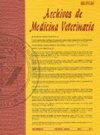Isolation, identification, and antimicrobial susceptibility of Brucella spp. cultured from cows and goats manure in Mexico
Q Veterinary
引用次数: 7
Abstract
espanolLa brucelosis es una zoonosis distribuida mundialmente que afecta varias especies animales. Los humanos se infectan por el contacto con animales infectados, sus excreciones o por la ingesta de derivados lacteos no pasteurizados. Las heces excretadas por el ganado se usan como fertilizante en paises no desarrollados. Estudios microbiologicos han alertado sobre el riesgo de las heces o estiercol como vector de diseminacion de microorganismos patogenos. El objetivo de este trabajo fue aislar Brucella de heces de vacas y cabras y evaluar la sensibilidad contra antimicrobianos mediante el metodo de E-test. Se analizaron heces de vacas y cabras serologicamente positivas a brucelosis de una region endemica de Mexico. El aislamiento de Brucella se llevo a cabo en un medio de preenriquecimiento y posteriormente se aislo en medio selectivo. La identificacion se realizo mediante pruebas microbiologicas y por PCR. Se obtuvieron 10 aislados de Brucella spp., que fueron positivos a la amplificacion del gen especifico de genero que codifica para la proteina BCSP31 y mediante multiplex Bruce-Ladder se identifico la especie. Se demostro la presencia de B. melitensis, B. abortus y B. suis en las heces de las vacas, mientras que B. abortus solo se aislo de las cabras. Ninguna cepa vacunal se encontro en el estudio. Algunos aislados fueron resistentes a ciprofloxacina, levofloxacina, trimetoprim-sulfametoxazol, y rifampicina. Las heces de animales infectados representan un riesgo de exposicion a Brucella. Se requieren estudios mas detallados para evaluar el factor de riesgo asociado a la materia fecal contaminada con Brucella en regiones endemicas. EnglishBrucellosis is a zoonosis that affects many animal species worldwide. Humans are often infected through direct animal contact, through contact with animal excretions, or through ingestion of unpasteurized dairy products. Livestock manure is extensively used as a pasture fertilizer in many production systems, especially in non-developed countries. Some microbiological studies warn of the risk of manure being a disseminator vector of pathogenic microorganisms. The present study aimed to isolate Brucella in manure from cows and goats that were serologically positive for brucellosis in an endemic region of Mexico. We then used E-test methods to evaluate the isolated microorganisms' susceptibility to antimicrobial agents in vitro. Brucella isolation was performed via a pre-enriched selective culture, and subcultures using selective agar plates. Isolates were identified using microbiological tests as well as BCSP31 PCR and Bruce-Ladder multiplex PCR. We isolated 10 Brucella spp. strains, all of which amplified the genus-specific gene that encodes the BCSP31 protein. The species were identified using multiplex PCR. Interestingly, B. melitensis, B. abortus, and B. suis were isolated from cow manure, while B. abortus was just isolated from goat manure. The isolates did not include any strains that are routinely vaccinated against. Some isolates were resistant to ciprofloxacin, levofloxacin, trimethoprim-sulfamethoxazole, and rifampicin. Manure from infected animals could represent a vehicle for human exposure to Brucella. More detailed studies are needed to evaluate Brucella-contaminated manure as a risk factor in endemic regions.从墨西哥牛和山羊粪便中培养的布鲁氏菌的分离、鉴定和抗菌敏感性
西班牙布鲁氏菌病是一种分布在世界各地的人畜共患病,影响多种动物。人类通过接触受感染的动物、它们的排泄物或摄入未经巴氏消毒的乳制品而感染。在不发达国家,牛的粪便被用作肥料。微生物学研究对粪便或粪便作为致病性微生物传播媒介的风险提出了警告。本研究的目的是从牛和山羊粪便中分离布鲁氏菌,并通过E-test方法评价其对抗菌素的敏感性。本研究的目的是分析墨西哥布鲁氏菌病流行地区血清呈阳性的牛和山羊的粪便。在预浓缩培养基中分离布鲁氏菌,然后在选择性培养基中分离。通过微生物检测和PCR进行鉴定。获得10株布鲁氏菌分离株,对编码BCSP31蛋白的特定基因扩增呈阳性,并通过多重布鲁氏菌阶梯进行物种鉴定。在牛的粪便中发现了melitensis, B. abortus和B. suis,而B. abortus只从山羊中分离出来。在研究中没有发现疫苗株。一些分离物对环丙沙星、左氧氟沙星、甲氧苄氨嘧啶-磺胺甲恶唑和利福平具有耐药性。受感染动物的粪便有接触布鲁氏菌的危险。需要进行更详细的研究,以评估流行地区布鲁氏菌污染粪便的相关危险因素。英国布鲁氏菌病是一种影响世界各地许多动物的人畜共患病。人类经常通过直接接触动物、接触动物排泄物或摄入未经巴氏消毒的乳制品而感染。在许多生产系统中,特别是在不发达国家,牲畜被广泛用作牧场肥料。= =地理= =根据美国人口普查,这个县的总面积为,其中土地和(0.964平方公里)水。本研究的目的是从墨西哥一个地方性地区布鲁氏菌病血清学阳性的牛和山羊中分离出马路布鲁氏菌。然后我们使用电子检测方法来评估分离的微生物对抗菌药物的体外敏感性。布鲁氏菌的分离是通过预富集选择性培养和选择性琼脂板培养进行的。通过微生物试验、BCSP31 PCR和Bruce-Ladder多重PCR鉴定分离物。我们分离了10个布鲁氏菌菌株,所有菌株都扩增了编码BCSP31蛋白的属特异性基因。它的自然栖息地是亚热带或热带潮湿低地森林。Interestingly b b . melitensis、b . abortus和猪被属于牛粪肥,同时b . abortus was just属于from goat粪肥。分离株不包括常规接种疫苗的任何菌株。= =地理= =根据美国人口普查,这个县的面积为。来自受感染动物的Manure可能是人类接触布鲁氏菌的途径。需要进行更详细的研究,以评估受布鲁氏菌污染的马路作为流行地区的一种危险因素。
本文章由计算机程序翻译,如有差异,请以英文原文为准。
求助全文
约1分钟内获得全文
求助全文
来源期刊

Archivos De Medicina Veterinaria
农林科学-兽医学
CiteScore
0.38
自引率
0.00%
发文量
0
审稿时长
>36 weeks
期刊介绍:
Archivos de Medicina Veterinaria is published by the Facultad de Ciencias Veterinarias, Universidad Austral de Chile. Archivos de Medicina Veterinaria publishes, in both spanish and english, original scientific contributions containing the latest developments and discoveries in Veterinary Sciences, covering topics such as Animal Health and Production, Animal Welfare, Preventive Medicine, Zoonosis, Pharmacology and Therapeutics, methods of diagnosis and other areas related to Veterinary Science. The journal was founded in 1969 and has 40 years of uninterrupted publishing. Since 2006 it publishes 3 issues per year.
 求助内容:
求助内容: 应助结果提醒方式:
应助结果提醒方式:


